Numerical Analysis of Interbedded Anti-Dip Rock Slopes Based on Discrete Element Modeling: A Case Study
Abstract
:1. Introduction
2. Geological Background
3. Engineering Geological Model
3.1. Model Setup
3.2. Parameter Calibration
3.3. Numerical Test Scheme
- (1)
- Effect of a joint in the rock layers on the stability of the interbedded anti-dip rock slope. A slope-free surface was designed with an irregular step shape based on the true excavation sequence (Figure 1), and the dip angle of each rock layer was set to 20°. For the model containing joints, joints with a 70° inclination angle and a 3 m length were located in the vicinity of the free slope surface, which was perpendicular to the bedding plane (Figure 2a). Furthermore, one slope without joints was designed to compare the failure characteristics (Figure 2b).
- (2)
- Effect of the inclination angle of the rock layers on the stability of the anti-dip interbedded rock slope. The irregular slope-free surface was simplified into a straight line in the numerical model, and the inclination angle of the rock stratum was set to 20° or 70° (Figure 2c,d).
- (3)
4. Results
4.1. Influence of Joints in Rock Strata on the Stability of Interbedded Anti-Dip Rock Slopes
4.1.1. Failure Characteristic of the Slopes with Joints
4.1.2. Slope Stability without the Presence of Joints
4.2. Influence of the Dip Angle of Rock Layers on the Stability of an Anti-Dip Interbedded Rock Slope
4.2.1. Failure Mode
4.2.2. Analysis of Failure
- (1)
- Fragmentation Characteristics
- (2)
- Deformation characteristics
- (3)
- Stress distribution characteristics
4.3. Influence of the Slope Angle on the Stability of an Anti-Dip Interbedded Rock Slope
4.3.1. Cracks Distribution Characteristics
4.3.2. Comparative Analysis of Fragmentation, Stress, and Displacement
5. Discussion
6. Conclusions
- For the interbedded anti-dip rock slope numerical model with an irregular slope surface and joints, the pre-existing joints in the rock stratum promote the shear dislocation of particles, resulting in crack initiation. The failure mode is shear-slip instability failure.
- The existence of joints induces the generation of cracks in the rock slope, increases the crack density, and accelerates the process of slope failure but does not change its failure mode.
- The inclination angle of the rock stratum affects the instability state of the interbedded anti-dip rock slope. When the dip angle of the rock stratum is small, shear-slip instability failure occurs. The gravitational moment increases with an increasing dip angle, which leads to toppling-slip compound failure along the slip zone.
- Shear-slip failure occurs in an interbedded anti-dip rock slope with a small slope angle. However, the failure mode of an anti-dip interbedded rock slope with a large slope angle is a flexural toppling-slip compound failure. The overturning and toppling characteristics of a slope with a large slope angle are obvious.
- These simulation results can contribute to a better understanding of the failure mechanisms of interbedded anti-dip rock slopes under different geological conditions and provide a reference for disaster prevention.
Author Contributions
Funding
Data Availability Statement
Conflicts of Interest
References
- Alejano, L.R.; Gómez-Márquez, I.; Martínez-Alegría, R. Analysis of a Complex Toppling-Circular Slope Failure. Eng. Geol. 2010, 114, 93–104. [Google Scholar] [CrossRef]
- Gu, D.; Huang, D. A Complex Rock Topple-Rock Slide Failure of an Anaclinal Rock Slope in the Wu Gorge, Yangtze River, China. Eng. Geol. 2016, 208, 165–180. [Google Scholar] [CrossRef]
- Li, Z.; Wang, J.; Li, L.; Wang, L.; Liang, R.Y. A Case Study Integrating Numerical Simulation and GB-InSAR Monitoring to Analyze Flexural Toppling of an Anti-Dip Slope in Fushun Open Pit. Eng. Geol. 2015, 197, 20–32. [Google Scholar] [CrossRef]
- Liu, Y.; Huang, D.; Peng, J.; Guo, Y. Analysis of the Effect of Rock Layer Structure on the Toppling Failure Evolution of Soft-Hard Interbedded Anti-Dip Slopes. Eng. Fail. Anal. 2023, 145, 107005. [Google Scholar] [CrossRef]
- Xie, L.; Zhu, Q.; Qin, Y.; Wang, J.; Qian, J. Study on Evolutionary Characteristics of Toppling Deformation of Anti-Dip Bank Slope Based on Energy Field. Sustainability 2020, 12, 7544. [Google Scholar] [CrossRef]
- Wang, R.; Zhao, W.; Nian, T.; Liu, C.; Wu, H. Centrifuge Model Test on Anti-Dip Rock Slopes with Unequal Thicknesses Subjected to Flexural Toppling Failure. KSCE J. Civ. Eng. 2022, 26, 2575–2587. [Google Scholar] [CrossRef]
- Dong, M.; Zhang, F.; Lv, J.; Fei, Y.; Li, Z. Study of Stability Influencing Factors of Excavated Anti-Dip Rock Slope. KSCE J. Civ. Eng. 2020, 24, 2293–2303. [Google Scholar] [CrossRef]
- Liu, C.H.; Jaksa, M.B.; Meyers, A.G. Toppling Mechanisms of Rock Slopes Considering Stabilization from the Underlying Rock Mass. Int. J. Rock Mech. Min. Sci. 2010, 47, 348–354. [Google Scholar] [CrossRef]
- Johari, A.; Fazeli, A.; Javadi, A.A. An Investigation into Application of Jointly Distributed Random Variables Method in Reliability Assessment of Rock Slope Stability. Comput. Geotech. 2013, 47, 42–47. [Google Scholar] [CrossRef]
- Johari, A.; Mehrabani Lari, A. System Probabilistic Model of Rock Slope Stability Considering Correlated Failure Modes. Comput. Geotech. 2017, 81, 26–38. [Google Scholar] [CrossRef]
- Shahsavar, J.; Johari, A.; Binesh, S. Stochastic Analysis of Rock Slope Stability Considering Cracked Rock Masses. In Proceedings of the International Conference on Civil Engineering: Modern and Practical Findings, Shiraz, Iran, 8 December 2021. [Google Scholar]
- Huang, D.; Ma, H.; Huang, R.; Peng, J.; Luo, S. Deep-Seated Toppling Deformations at the Dam Site of the Miaowei Hydropower Station, Southwest China. Eng. Geol. 2022, 303, 106654. [Google Scholar] [CrossRef]
- Ning, Y.; Zhang, G.; Tang, H.; Shen, W.; Shen, P. Process Analysis of Toppling Failure on Anti-Dip Rock Slopes Under Seismic Load in Southwest China. Rock. Mech. Rock. Eng. 2019, 52, 4439–4455. [Google Scholar] [CrossRef]
- Cheng, H.; Han, L.; Wu, Z.; Zhou, X. Experimental Study on the Whole Failure Process of Anti-Dip Rock Slopes Subjected to External Loading. Bull. Eng. Geol. Environ. 2021, 80, 6597–6613. [Google Scholar] [CrossRef]
- Gong, Y.; Yao, A.; Li, Y.; Li, Y.; Li, Y.; Sun, Y. Model Test Study on Sliding-Toppling Composite Deformation Evolution of Anti-Dip Layered Rock Slope. Bull. Eng. Geol. Environ. 2023, 82, 194. [Google Scholar] [CrossRef]
- Chen, C.-C.; Li, H.-H.; Chiu, Y.-C.; Tsai, Y.-K. Dynamic Response of a Physical Anti-Dip Rock Slope Model Revealed by Shaking Table Tests. Eng. Geol. 2020, 277, 105772. [Google Scholar] [CrossRef]
- Zheng, Y.; Chen, C.; Liu, T.; Xia, K.; Liu, X. Stability Analysis of Rock Slopes against Sliding or Flexural-Toppling Failure. Bull. Eng. Geol. Environ. 2018, 77, 1383–1403. [Google Scholar] [CrossRef]
- Zhang, G.; Wang, F.; Zhang, H.; Tang, H.; Li, X.; Zhong, Y. New Stability Calculation Method for Rock Slopes Subject to Flexural Toppling Failure. Int. J. Rock Mech. Min. Sci. 2018, 106, 319–328. [Google Scholar] [CrossRef]
- Zheng, Y.; Chen, C.; Meng, F.; Liu, T.; Xia, K. Assessing the Stability of Rock Slopes with Respect to Flexural Toppling Failure Using a Limit Equilibrium Model and Genetic Algorithm. Comput. Geotech. 2020, 124, 103619. [Google Scholar] [CrossRef]
- Wang, R.; Zheng, Y.; Chen, C.; Zhang, W. Theoretical and Numerical Analysis of Flexural Toppling Failure in Soft-Hard Interbedded Anti-Dip Rock Slopes. Eng. Geol. 2023, 312, 106923. [Google Scholar] [CrossRef]
- Ren, Z.; Chen, C.; Sun, C.; Wang, Y. Dynamic Analysis of the Seismo-Dynamic Response of Anti-Dip Bedding Rock Slopes Using a Three-Dimensional Discrete-Element Method. Appl. Sci. 2022, 12, 4640. [Google Scholar] [CrossRef]
- Liu, X.; Liu, Y.; Lu, Y.; Li, X.; Li, P. Numerical Analysis of Evaluation Methods and Influencing Factors for Dynamic Stability of Bedding Rock Slope. J. Vibroeng. 2017, 19, 1937–1961. [Google Scholar] [CrossRef]
- Deng, Z.; Liu, X.; Liu, Y.; Liu, S.; Han, Y.; Liu, J.; Tu, Y. Model Test and Numerical Simulation on the Dynamic Stability of the Bedding Rock Slope under Frequent Microseisms. Earthq. Eng. Eng. Vib. 2020, 19, 919–935. [Google Scholar] [CrossRef]
- Yang, C.; Feng, N.; Zhang, J.; Bi, J.; Zhang, J. Research on Time-Frequency Analysis Method of Seismic Stability of Covering-Layer Type Slope Subjected to Complex Wave. Environ. Earth Sci. 2015, 74, 5295–5306. [Google Scholar] [CrossRef]
- Li, H.; Lv, Y.; Liu, Y.; Li, J.; Yao, W.; Qiao, W. Seismic Response of the Stratified Anti-Dip Rock Slope. Disaster Adv. 2013, 6, 204–213. [Google Scholar]
- Jia, J.; Pei, X.; Liu, G.; Cai, G.; Guo, X.; Hong, B. Failure Mechanism of Anti-Dip Layered Soft Rock Slope under Rainfall and Excavation Conditions. Sustainability 2023, 15, 9398. [Google Scholar] [CrossRef]
- Orr, C.M.; Swindells, C.F.; Windsor, C.R. Open Pit Toppling Failures: Experience versus Analysis; International Association for Computing Methods and Advances in Geomechanics: Perth, WA, Australia, 1991; pp. 505–510. [Google Scholar]
- Song, D.; Liu, X.; Huang, J.; Wang, E.; Zhang, J. Characteristics of Wave Propagation through Rock Mass Slopes with Weak Structural Planes and Their Impacts on the Seismic Response Characteristics of Slopes: A Case Study in the Middle Reaches of Jinsha River. Bull. Eng. Geol. Environ. 2021, 80, 1317–1334. [Google Scholar] [CrossRef]
- Gong, W.J.; Tao, Z.G.; He, M.C.; Hou, H.J. Feasibility Analysis on the Support of Rock Slopes Against Flexural Toppling Failure Using the DDA Method-A Case Study. KSCE J. Civ. Eng. 2022, 26, 3847–3862. [Google Scholar] [CrossRef]
- Song, D.; Shi, W.; Wang, C.; Dong, L.; He, X.; Wu, E.; Zhao, J.; Lu, R. Numerical Investigation of a Local Precise Reinforcement Method for Dynamic Stability of Rock Slope under Earthquakes Using Continuum-Discontinuum Element Method. Sustainability 2023, 15, 2490. [Google Scholar] [CrossRef]
- Liu, G.; Ma, F.; Zhang, M.; Guo, J.; Jia, J. Y-Mat: An Improved Hybrid Finite-Discrete Element Code for Addressing Geotechnical and Geological Engineering Problems. Eng. Comput. 2022, 39, 1962–1983. [Google Scholar] [CrossRef]
- Pierce, M.; Mas Ivars, D.; Potyondy, D.; Cundall, P. A Synthetic Rock Mass Model for Jointed Rock. In Proceedings of the 1st Canada-US Rock Mechanics Symposium—Rock Mechanics Meeting Society’s Challenges and Demands, Vancouver, Canada, 1 May 2007; Volume 1. [Google Scholar]
- Potyondy, D.O.; Cundall, P.A. A Bonded-Particle Model for Rock. Int. J. Rock Mech. Min. Sci. 2004, 41, 1329–1364. [Google Scholar] [CrossRef]
- Liu, L.; Li, H.; Li, X.; Zhou, C.; Zhang, G. Simulation on Heterogeneous Rocks with a Flaw Using Grain-Based Discrete-Element Method. Géotech. Lett. 2021, 11, 1–10. [Google Scholar] [CrossRef]
- Tang, P.; Chen, G.-Q.; Huang, R.-Q.; Wang, D. Effect of the Number of Coplanar Rock Bridges on the Shear Strength and Stability of Slopes with the Same Discontinuity Persistence. Bull. Eng. Geol. Environ. 2021, 80, 3675–3691. [Google Scholar] [CrossRef]
- Huang, D.; Wang, J.; Liu, S. A Comprehensive Study on the Smooth Joint Model in DEM Simulation of Jointed Rock Masses. Granul. Matter 2015, 17, 775–791. [Google Scholar] [CrossRef]
- Cundall, P.A.; Strack, O.D.L. A Discrete Numerical Model for Granular Assemblies. Géotechnique 1979, 29, 47–65. [Google Scholar] [CrossRef]
- Itasca Consulting Group Inc. PFC2D Particle Flow Code in 2 Dimensions User’s Guide; Itasca: Minneapolis, MN, USA, 2016. [Google Scholar]
- Li, L.C.; Tang, C.A.; Zhu, W.C.; Liang, Z.Z. Numerical Analysis of Slope Stability Based on the Gravity Increase Method. Comput. Geotech. 2009, 36, 1246–1258. [Google Scholar] [CrossRef]
- Tang, P.; Chen, G.-Q.; Huang, R.-Q.; Zhu, J. Brittle Failure of Rockslides Linked to the Rock Bridge Length Effect. Landslides 2020, 17, 793–803. [Google Scholar] [CrossRef]
- Labuz, J.F.; Zang, A. Mohr–Coulomb Failure Criterion. Rock. Mech. Rock. Eng. 2012, 45, 975–979. [Google Scholar] [CrossRef]
- Wang, C.; Tannant, D.D.; Lilly, P.A. Numerical Analysis of the Stability of Heavily Jointed Rock Slopes Using PFC2D. Int. J. Rock Mech. Min. Sci. 2003, 40, 415–424. [Google Scholar] [CrossRef]
- Zhang, Z.; Dou, Z.; Xu, H.; Liu, Z. Shear behavior of Beishan granite fractures after thermal treatment. Eng. Fract. Mech. 2019, 213, 223–240. [Google Scholar]
- Meng, F.; Song, J.; Yue, Z.; Zhou, H.; Wang, X.; Wang, Z. Failure Mechanisms and Damage Evolution of Hard Rock Joints under High Stress: Insights from PFC2D Modeling. Eng. Anal. Bound. Elem. 2022, 135, 394–411. [Google Scholar] [CrossRef]
- Elekes, F.; Parteli, E.J.R. An Expression for the Angle of Repose of Dry Cohesive Granular Materials on Earth and in Planetary Environments. Proc. Natl. Acad. Sci. USA 2021, 118, e2107965118. [Google Scholar] [CrossRef] [PubMed]
- Potyondy, D.O. A Grain-Based Model for Rock: Approaching the True Microstructure. In Proceedings of the rock mechanics in the Nordic Countries, Kongsberg, Norway, 9–12 June 2010. [Google Scholar]
- Peng, J.; Wong, L.N.Y.; Teh, C.I. Influence of Grain Size Heterogeneity on Strength and Microcracking Behavior of Crystalline Rocks. JGR Solid Earth 2017, 122, 1054–1073. [Google Scholar] [CrossRef]
- Hu, X.; Xie, N.; Zhu, Q.; Chen, L.; Li, P. Modeling Damage Evolution in Heterogeneous Granite Using Digital Image-Based Grain-Based Model. Rock. Mech. Rock. Eng. 2020, 53, 4925–4945. [Google Scholar] [CrossRef]
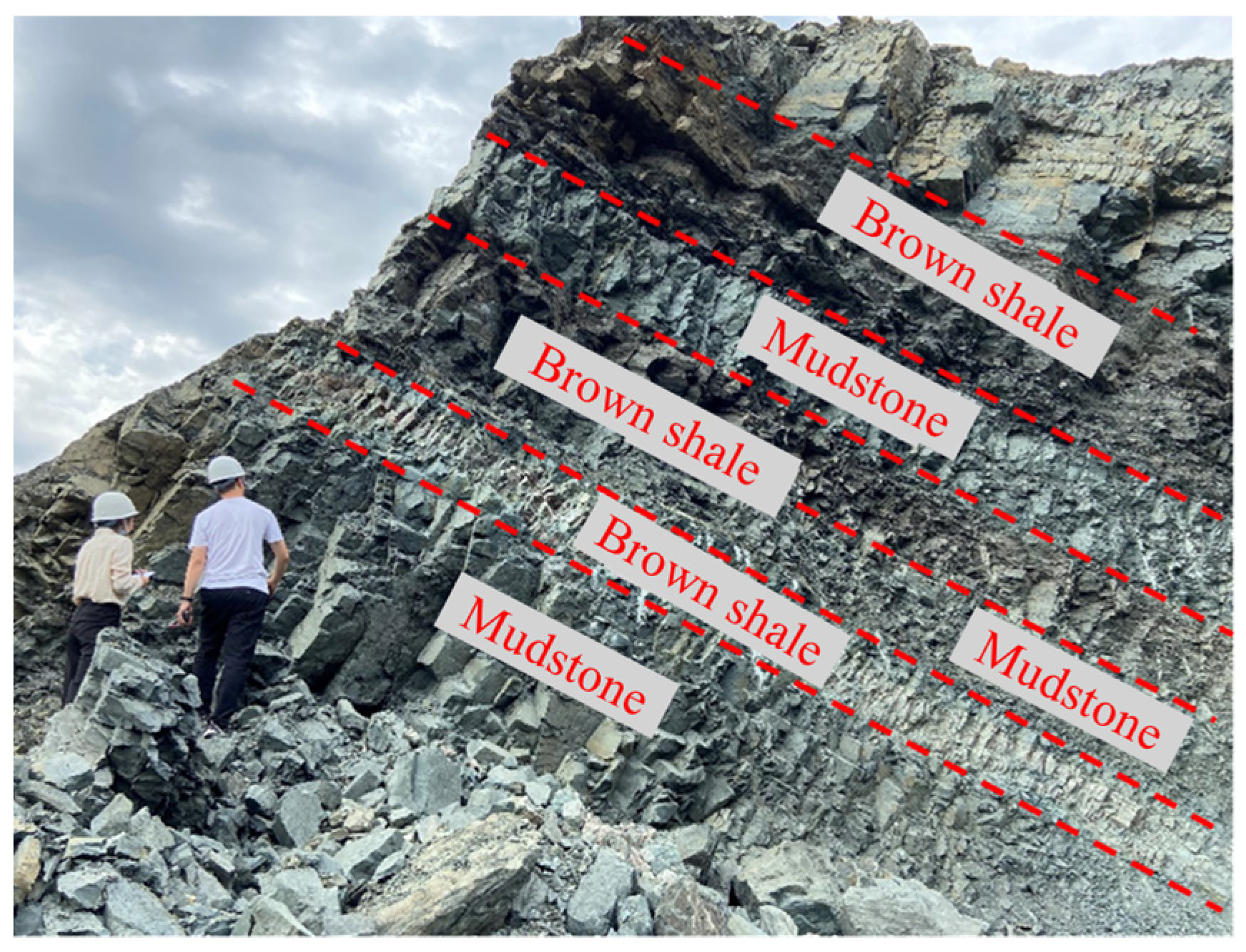

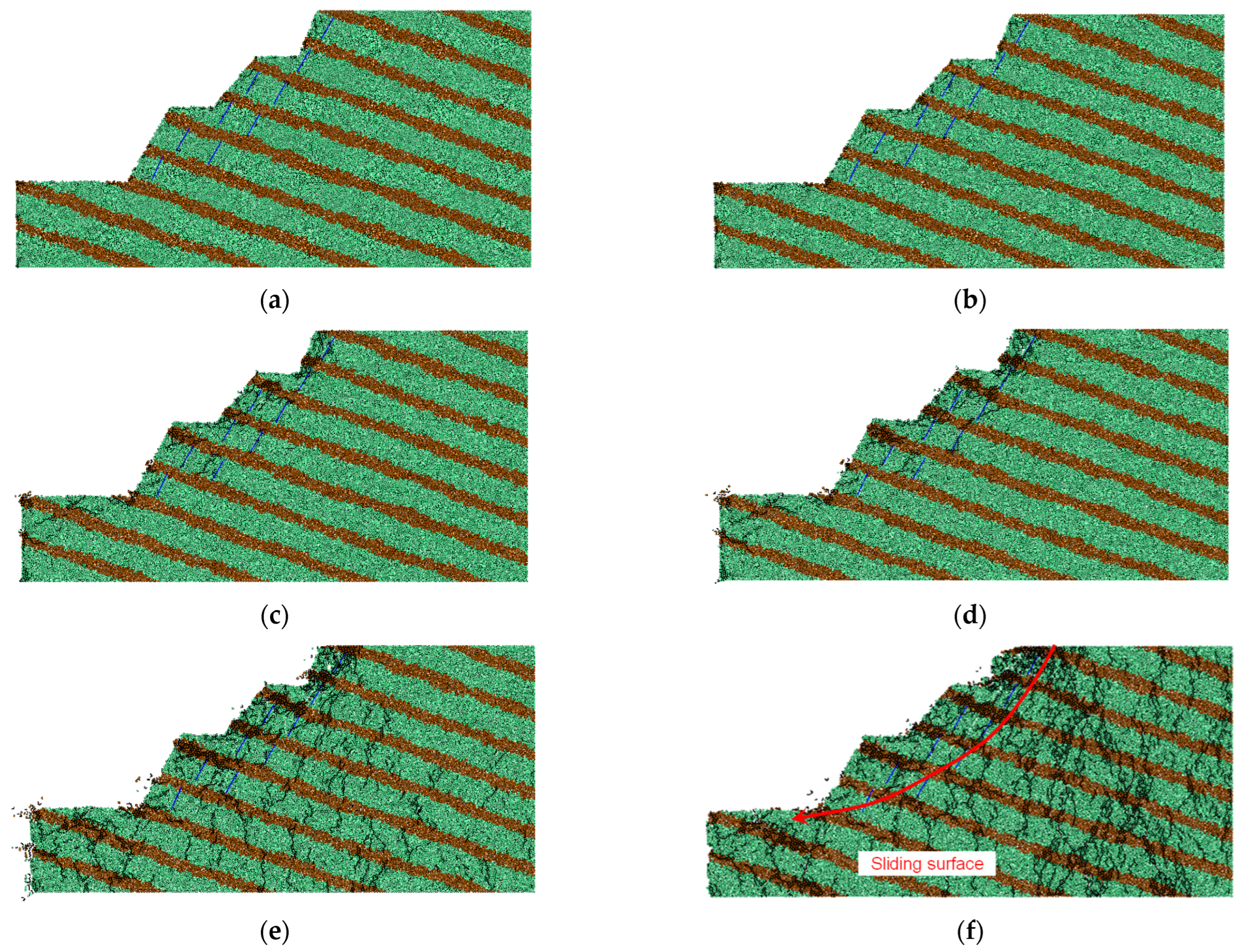


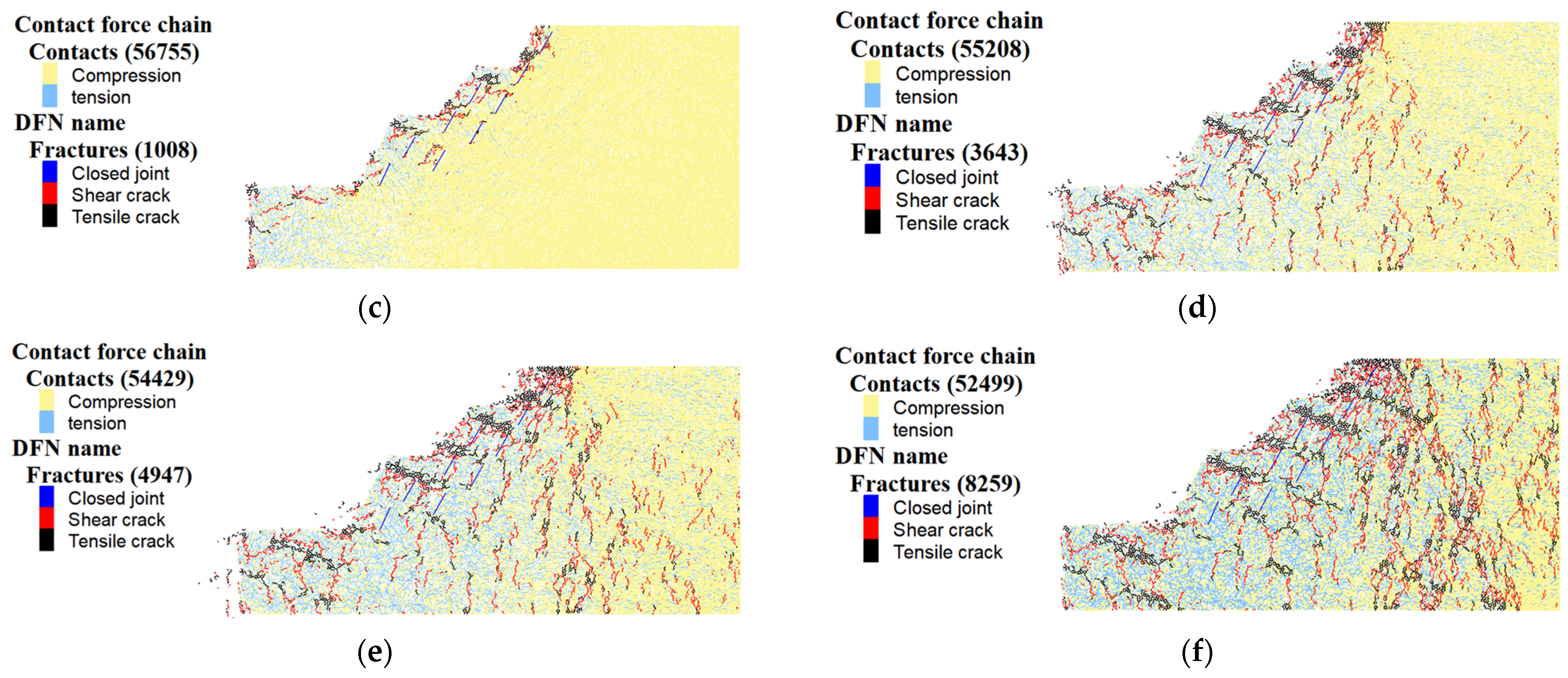

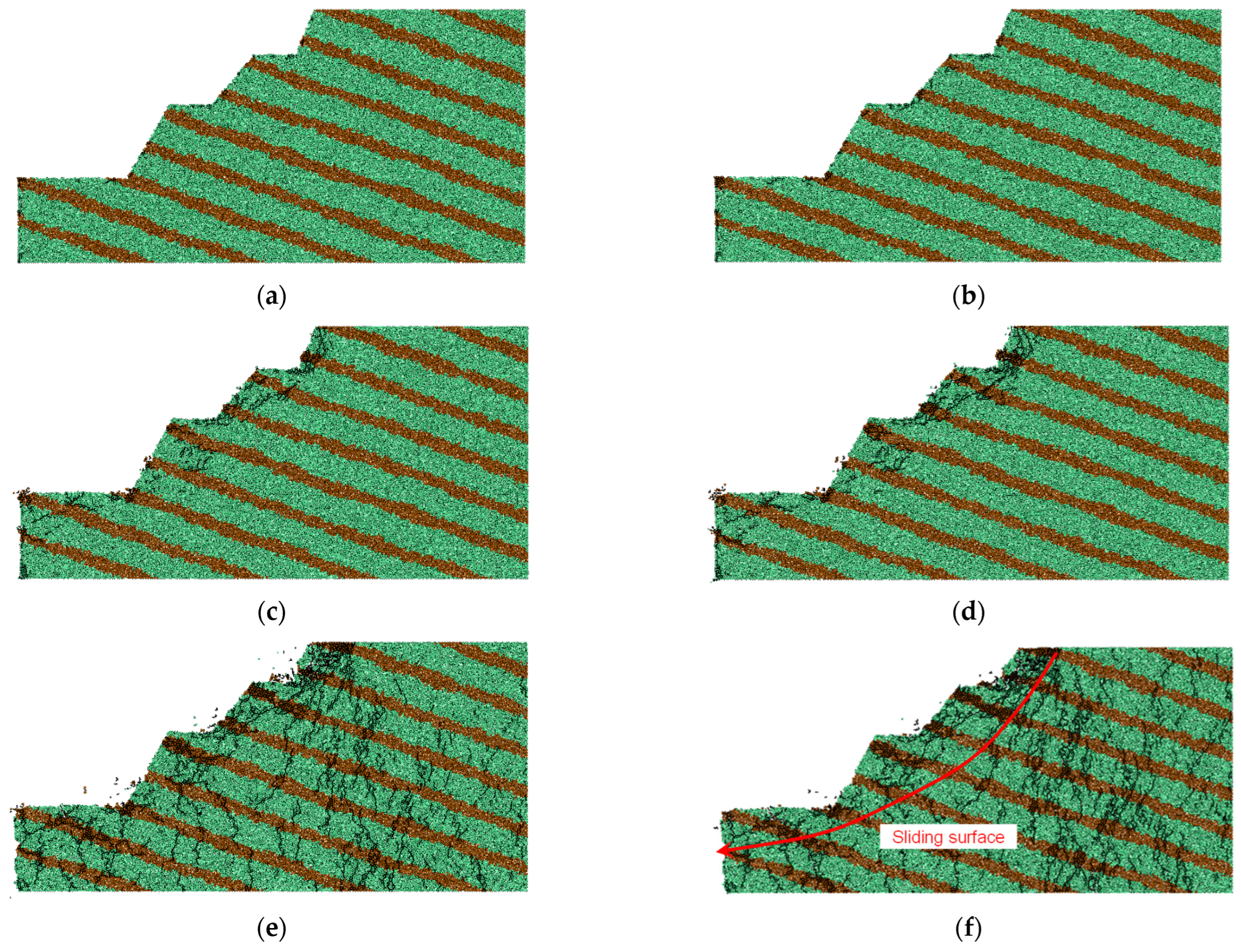
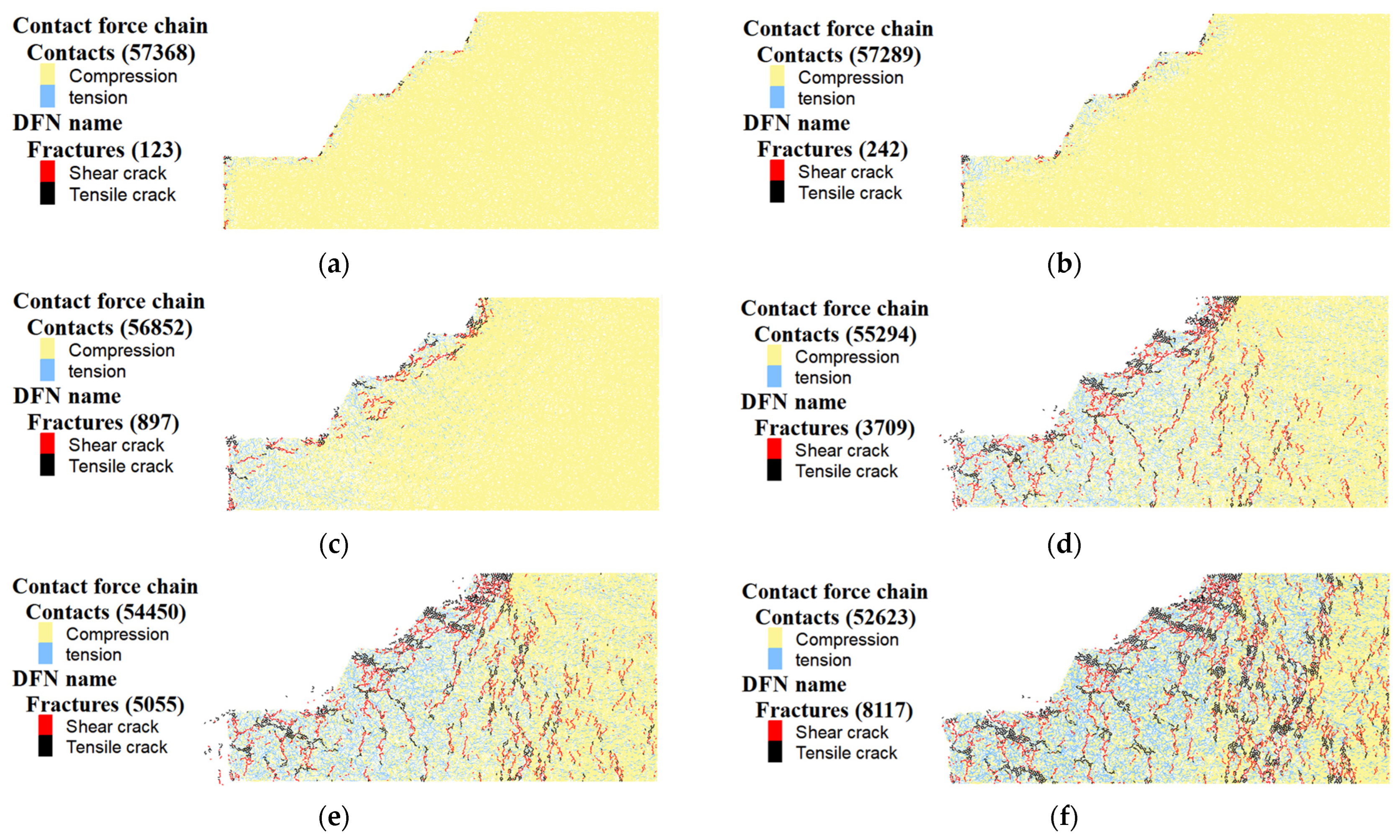
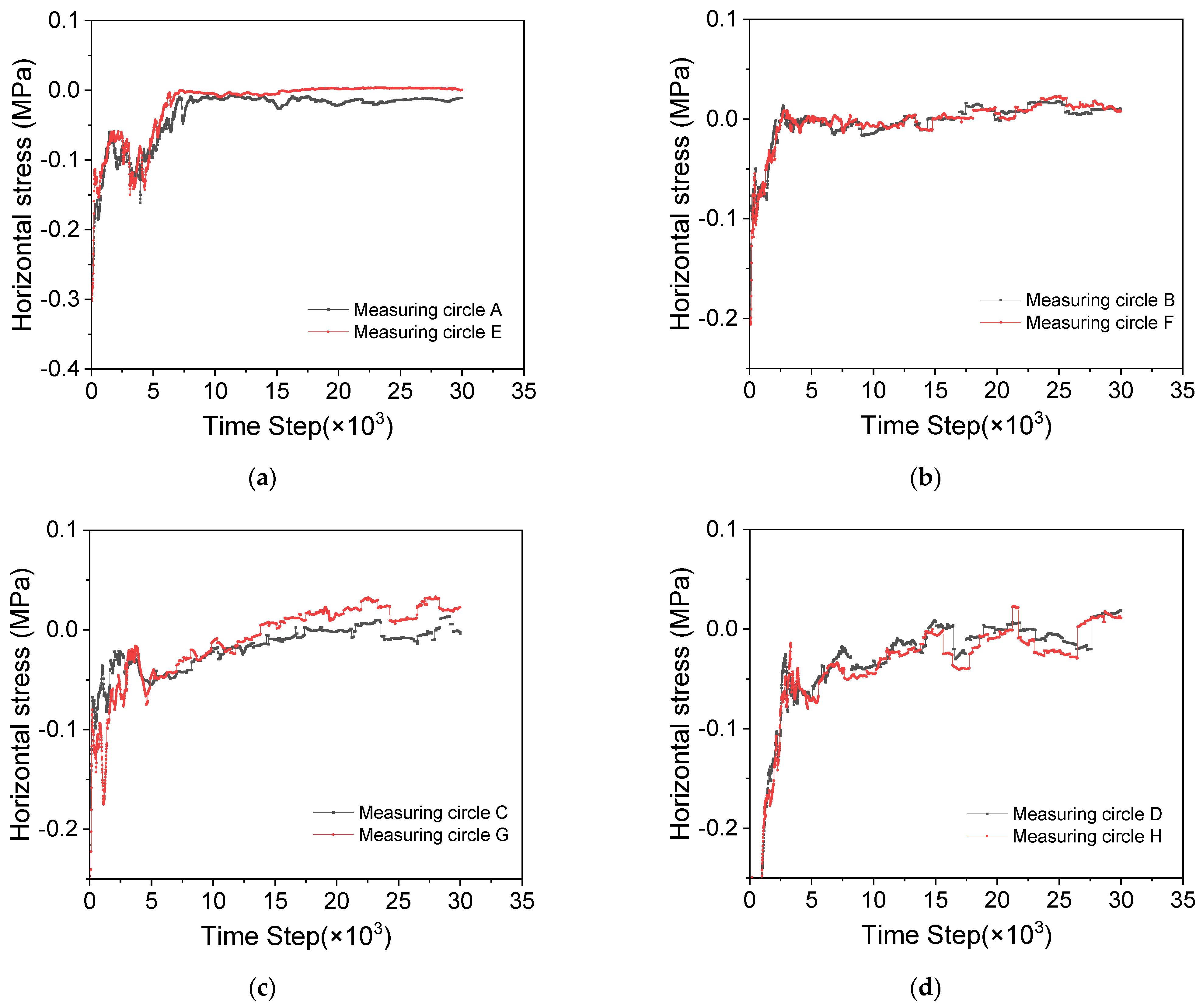
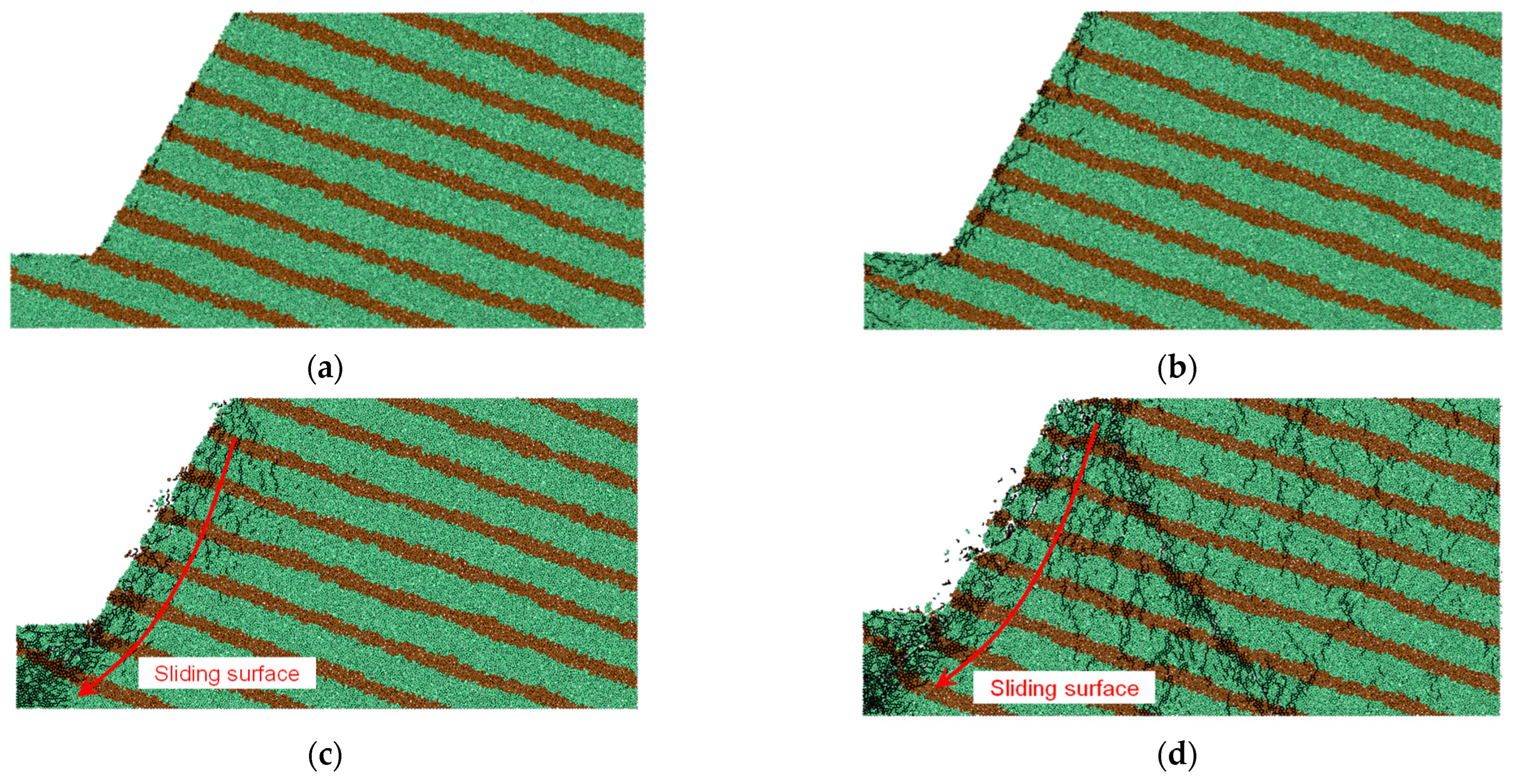
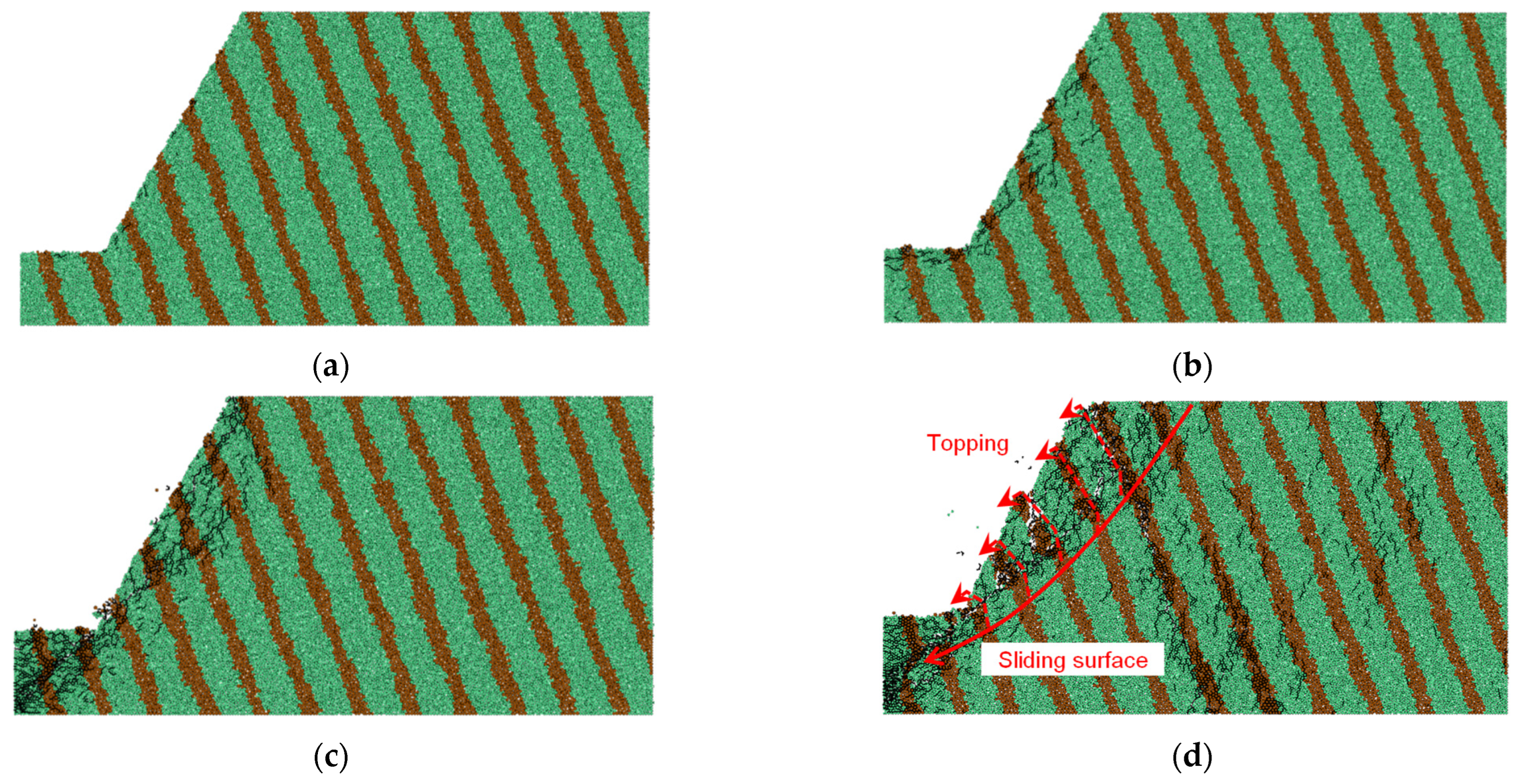



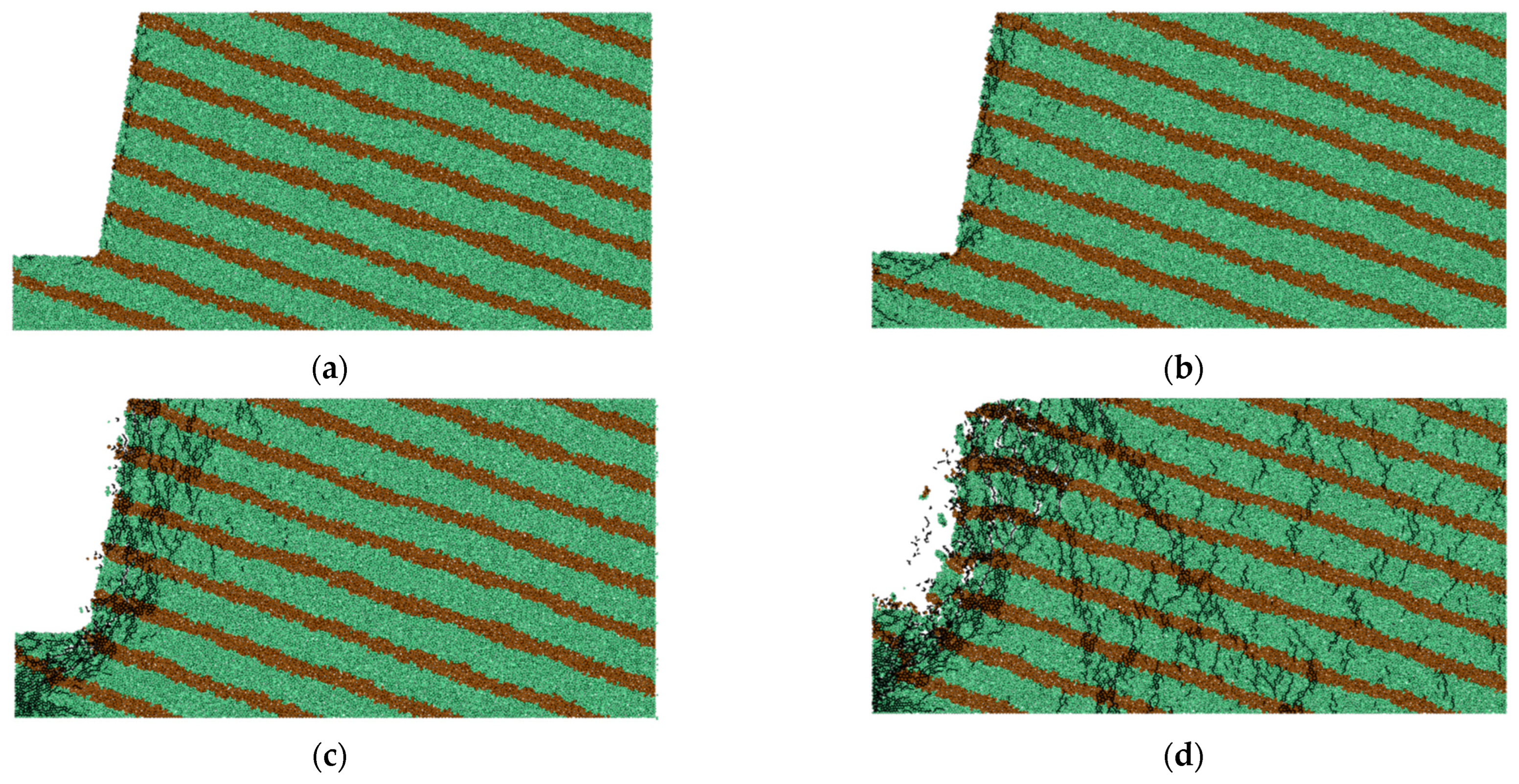

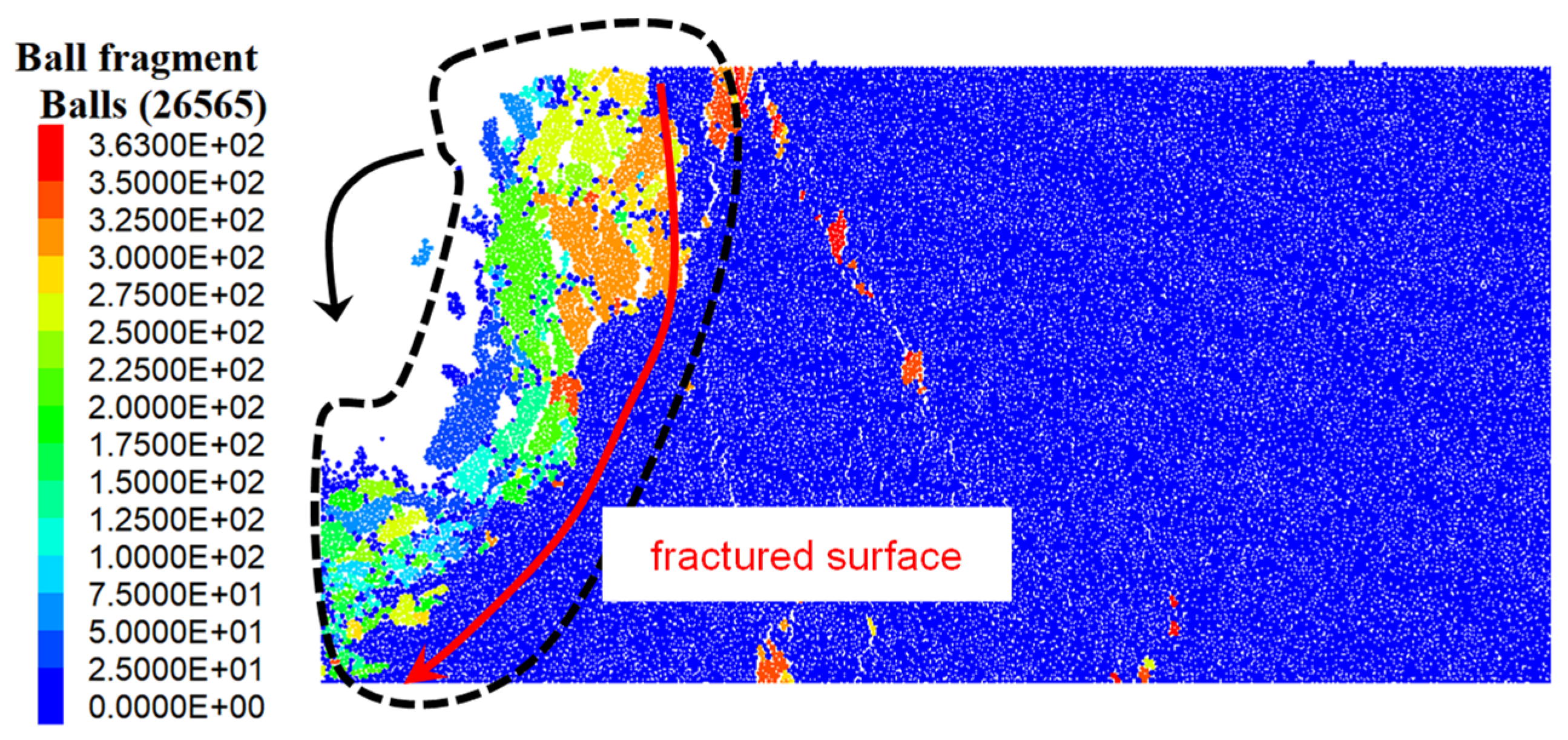
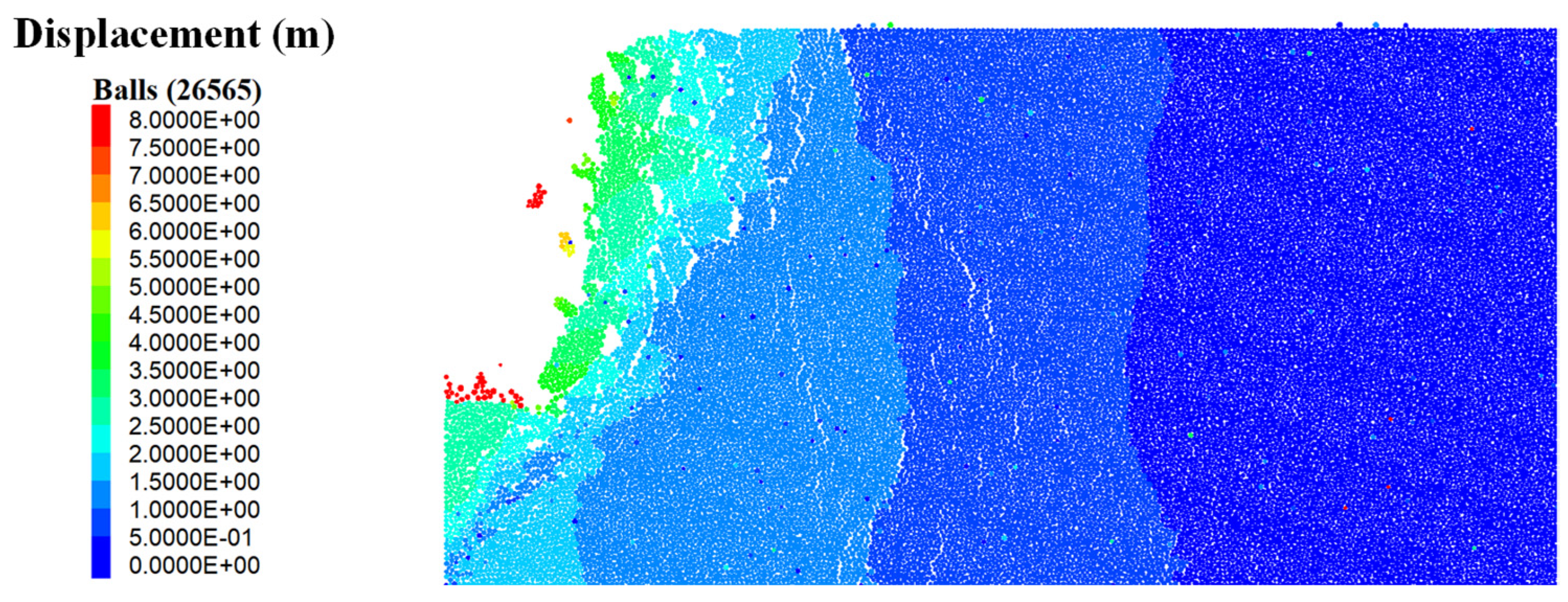
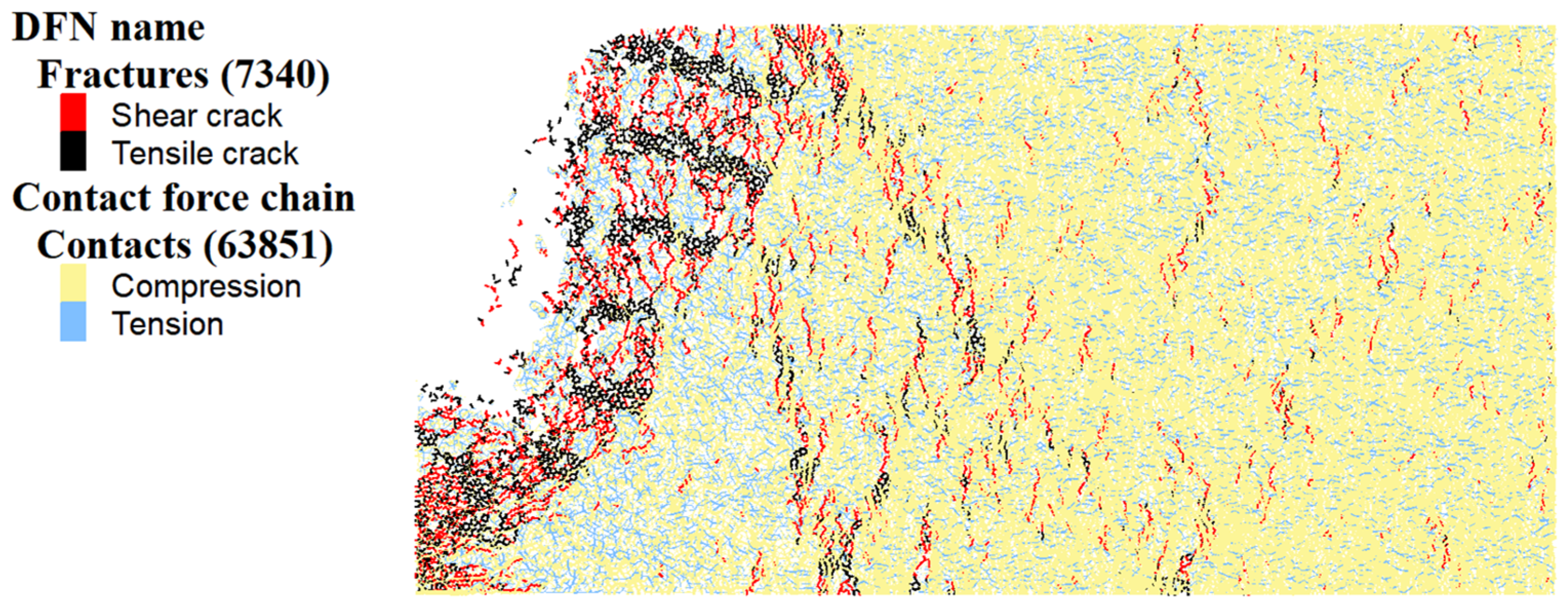
| Strength Parameters | Rock Type | |||
|---|---|---|---|---|
| Mudstone | Brown Shale | |||
| Field Investigation Data | PFC 2D | Field Investigation Data | PFC 2D | |
| ρ (kg/m3) | 2300 | 2300 | 2100 | 2100 |
| c (0.1 MPa) | 1.50 | 1.62 | 3 | 2.96 |
| φ (°) | 30.0 | 30.0 | 17.0 | 16.2 |
| E (GPa) | 3 | 2.85 | 3 | 2.93 |
| Rock Type | Particle Parameters | Parallel Bond Parameters | ||||||
|---|---|---|---|---|---|---|---|---|
| R (m) | Ec (GPa) | Kn/Ks | (GPa) | Normal Strength (MPa) | Shear Strength (MPa) | µ | ||
| Mudstone | 0.1–0.15 | 0.064 | 1.0 | 0.064 | 1.0 | 3.86 | 1.56 | 0.20 |
| Brown shale | 0.12–0.18 | 0.048 | 1.4 | 0.048 | 1.4 | 1.66 | 1.22 | 0.25 |
| Model | Kn (GPa) | Ks (GPa) | Tensile Strength (MPa) | Cohesion (MPa) | Dilation Angle (°) | µ |
|---|---|---|---|---|---|---|
| LM | 0.03 | 0.03 | / | / | / | 0.05 |
| SJM | 0.02 | 0.02 | 0.1 | 0.5 | 0 | 0.7 |
Disclaimer/Publisher’s Note: The statements, opinions and data contained in all publications are solely those of the individual author(s) and contributor(s) and not of MDPI and/or the editor(s). MDPI and/or the editor(s) disclaim responsibility for any injury to people or property resulting from any ideas, methods, instructions or products referred to in the content. |
© 2023 by the authors. Licensee MDPI, Basel, Switzerland. This article is an open access article distributed under the terms and conditions of the Creative Commons Attribution (CC BY) license (https://creativecommons.org/licenses/by/4.0/).
Share and Cite
Li, M.; Yue, Z.; Ji, H.; Xiu, Z.; Han, J.; Meng, F. Numerical Analysis of Interbedded Anti-Dip Rock Slopes Based on Discrete Element Modeling: A Case Study. Appl. Sci. 2023, 13, 12583. https://doi.org/10.3390/app132312583
Li M, Yue Z, Ji H, Xiu Z, Han J, Meng F. Numerical Analysis of Interbedded Anti-Dip Rock Slopes Based on Discrete Element Modeling: A Case Study. Applied Sciences. 2023; 13(23):12583. https://doi.org/10.3390/app132312583
Chicago/Turabian StyleLi, Ming, Zhufeng Yue, Hongguang Ji, Zhanguo Xiu, Jianhua Han, and Fanzhen Meng. 2023. "Numerical Analysis of Interbedded Anti-Dip Rock Slopes Based on Discrete Element Modeling: A Case Study" Applied Sciences 13, no. 23: 12583. https://doi.org/10.3390/app132312583




